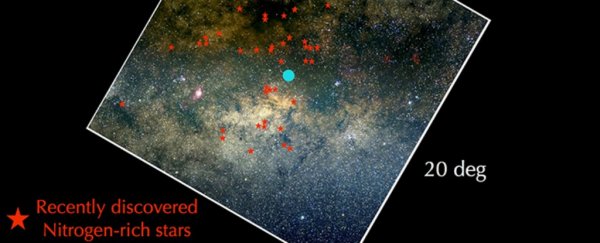Astronomers have discovered a new family of stars in the centre of the Milky Way, which they're calling N-rich stars, because of their unusually high levels of nitrogen.
Not only do these strange new stars deepen our understanding of what lies at the heart of our own galaxy, their discovery could shed light on how globular clusters - strange, spherical groups of stars that orbit the centre of a galaxy - formed during the creation of the Milky Way some 13.2 billion years ago.
"This is a very exciting finding that helps us address fascinating questions such as what is the nature of the stars in the inner regions of the Milky Way, how globular clusters formed, and what role they played in the formation of the early Milky Way - and by extension the formation of other galaxies," said lead researcher Ricardo Schiavon, from Liverpool John Moores University in the UK.
The stars were found during a collaborative project known as the Apache Point Observatory Galactic Evolution Experiment (APOGEE), which collates a remarkable amount of infrared data from the night sky by capturing signatures of hundreds of thousands of stars.
Usually the stars around the centre of our galaxy are shrouded by dust, but Schiavon and his team were able to use infrared star signals to reveal that there are a whole lot of nitrogen-rich stars in there that weren't like anything they'd expected to find.
"The centre of the Milky Way is poorly understood, because it is blocked from view by intervening dust," said Schiavon."Observing in the infrared, which is less absorbed by dust than visible light, APOGEE can see the centre of the galaxy better than other teams."
Since these newly found 'N-rich' stars contain more nitrogen than the stars around them, the team suggests that they might have formed from the remains of globular clusters - giant groups of millions of stars that were formed during the Milky Way's early days and then collapsed some time later.
"From our observations, we could determine the chemical compositions of thousands of stars, among which we spotted a considerable number of stars that differed from the bulk of the stars in the inner regions of the galaxy, due to their very high abundance of nitrogen," Schiavon explains.
"While not certain, we suspect that these stars resulted from globular cluster destruction. They could also be the by-products of the first episodes of star formation taking place at the beginning of the galaxy's history," he adds.
This means that a better understanding of the newly found star family might eventually shed new light not just on how they formed but how our galaxy and others like it formed as well - which is one of the biggest questions in astronomy.
If that's not cool enough, the stars might also be some of the oldest celestial bodies in the Milky Way, forming right alongside the galactic core.
"Last, but not least, N-rich stars could be the oldest stars in the galaxy, the by-products of chemical enrichment by the first stellar generations formed in the heart of the galaxy," the team writes.
It's going to take more research on this mysterious new star family to better understand what they are and how they formed. But as our tools for peering into the heart of our galaxy get more advanced, hopefully we'll soon have a lot more data to go off.
The study was published in Monthly Notices of the Royal Astronomical Society.
